Brazil, Amazon – River Trip to Parintins
Citizen Journalism, Estilo de Vida 02/12/2011,| Above, the Amazon State Flag.
Well, first, how to get there? Once you are in Manaus, the capital of the state of Amazonas in Brazil, there are two ways to get to Parintins: by plane, about a 1 hour trip, or by the Amazon River, 18 hours to get there and 24 hours or more to get back. Parintins has a great festival every year between June 28 and June 30. Fifty thousand people from all over the country and abroad come to participate. Apart from the Bull Festival, it is a nice place to visit year round. But, in case all you want is to experience the Amazon River, you may go to Itacoatiara, which is nearer to Manaus and less tiring to get to. You see, riverboat trips are slow and long.
Of course, adventurous, I chose the river trip to Parintins. The idea was to see more of the tropical rain forest and maybe animals, too. Also, to learn more about the “Amazonenses” of other smaller cities. “Amazonense” is the name given to people born in the state of Amazonas. Rivers are the major means of transportation in this region of Brazil. Most cities grow and develop on their banks.
At the boat docks in Manaus, cargo and passengers are readied for the trip. Usually these river vessels stay harbored in Manaus for a whole day because this is where all the people from the smaller cities scattered along the river ways of the mighty Amazon, its branches and tributaries, come to sell their goods, crops and fish. They in turn buy clothing, groceries, seeds, gas, fuel, building materials, etc. The riverboats take on an average of 170 passengers plus many tons of cargo. On the boat, everyone brings a hammock. There are places for you to hang them and enjoy your trip in relative comfort. I could not really be at ease with mine at first. On the trip from Manaus to Parintins, I could hardly sleep. You see, it is not so easy to sleep in a hammock when you are not used to it. But on the way back I was so tired, I did sleep, at least for a couple of hours.
The first thing I did was to check what kind of hammock people used. Then in one of the many shops near the harbor, I bought mine, neither better nor worse. Next, I paid for my ticket and went on to choose a place for me to hang my hammock. Sounds simple, right? There’s not much to it, but if you happen to be late, most of the passengers will already be on board — a mass of people lying side-by-side and sometimes even on top of each other. In the photo above, do you see the woman’s net? (Brazilians call hammocks nets.) It is beside two other nets. The people in the photo are not relatives or anything like that; they just got to know each other that very moment. Brazilians tend to talk at a closer distance than British or Americans do. They mean no disrespect or intrusion. It is simply our way.
During the trip, three to four meals are served: dinner, morning breakfast, lunch and, if the boat is late, another meal before arrival. The food quality varies from boat to boat. Traveling to Parintins on the “Cidade de Alenquer” the food and its preparation was very good, on the way back I was not so fortunate… On the first day, before dinner, I was interested only in the rivers, the scenery and stuff like that. At the first meal, however, I got to learn more about the beautiful people from the states of Amazonas and Para. The meals are served on a rather small table that fits 12 at a time. With 170 some people onboard, one table on the first deck and another one — the same size — on the second deck, so about 85 people per table, right? Now everybody is hungry, the boat is three hours late, the engine’s on: po, po, po, po, pop popt … I thought to myself, this is going to be a mess. I was wrong, very wrong. I fell in love with these calm, clean and peaceful people. Yes, very clean. During the trip, some of them took up to four showers. They’d go towel in one hand something to dress in the other, and when they returned they’d spend up to 30 minutes combing, brushing, voluptuous — incredible.
Note, when the Europeans arrived in Brazil they where amazed about the nudity and the bathing habits of the natives — well, it is still true. At least the bathing thing, sometimes both. The bell rang and in an orderly way without much external control, they went to the table. There the food was set in medium-sized bowls and they served each other without hurry and in such a nice way. I took part in the second round. The bowls where refilled. I noticed then that no one was watching or comparing, getting more or less; they were at ease. You see, these are mostly very simple people. In general, they have a low level of education, low incomes and yet they have good manners, a very good heart and relate very well with each other.
Now night came. Soon, some of the hammocks were empty while others held more weight… Wow. Love on the boat was so simple. But what was funny was that you did not hear any sound at all. Before this, on the third deck, the top level of the boat, where there is a bar, the people danced, drank beer and socialized. But don’t take me wrong. This was good. Whole families, children, the elderly, they were all having a good time. Not everyone on board was there, of course. Some were down stairs sleeping or just relaxing. Later in deep silence, we all slept. Well most of us anyway. They are not uptight; they really feel free to enjoy themselves. Would that you were there, you’d feel respected all the time, no question.
The trip started in Manaus at the Black River. Thirty minutes later the confluence appeared — the Black River and the Solimoes River collide and give birth to the Amazon River. The Solimoes River is red with mud, the Black River, as the name suggests, has black waters, and the two do not mix for many kilometers. So on one side of the boat you have red water and on the other black — a real scene. It is fantastic. The Amazon is large — in some places more than six kilometers wide. Going down the river to Parintins or Itacoatiara is faster because you are traveling in the middle with the current, which is strong. On the way back, the boats travel very near the banks, doodling up every curve, so you may add from 6 to 10 hours to your trip. Should the captain try to go up by the middle, the current is so strong there, the boat wouldn’t even move. Sadly, I saw only one fish jump in the river and some birds. The Amazon is a highway for boats of all sizes going up and down. According to some of my fellow travelers, animals and even more birds can be seen on the branches and tributaries far from the main rivers because of the up and down movement of the boats.
Itacoatiara Port There are many cities on the riverbanks, like Itacoatiara. Once small, today Itacoatiara is a port through which wood and many other goods are exported to Europe, the U.S., Asia, etc. There is a road between Itacoatiara and Manaus. By river, it may take you eight to ten hours; by road, it may be only three. (So you may leave Manaus by boat in the morning, enjoy the trip, experience the river and later come back by taxi or bus.)
Itacoatiara Main St. It all starts in Itacoatiara pretty much like any other small village, A church, a health center to serve the formers nearby, soon someone puts up a bar that also sells groceries and the city develops.
Nowadays these places are not springing up without care. There are programs run by the Amazonas state government to help them develop with more planning. Sustainable development is the name of the game and is the key to preserving the rain forest and the people who live in it. Brazilians know that and are willing to fulfill the task — to take care of our share of the Amazon. Nevertheless, I must admit there is a lot that needs to be done. I was all the time worried about a piece of plastic I had in my pocket. I thought ‘this must not go to the river, Carlos! Be careful with your garbage!’ In the early morning, I was on the top deck inhaling the pure air, enjoying the scenery, at ease. The night before, I had put my garbage in the right place. The trashcan, right? Well, all of a sudden to my surprise I see two garbage bags flouting past the boat. Did someone from the crew throw that in? I immediately went downstairs and saw the trash can with new bags. I was mad. So mad I decided it was not a good time to go speak to the crew. But I later wrote to the port authorities. They said that they teach and that there are regulations, but people are hard to change. The next photo is my view from the top deck. I did not have my camera when the bags passed by unfortunately… My next trip, you can guess, right? Yes, go wild, experience the jungle! The Amazon River is so amazing. I recommend you take a trip down to see it for yourself. Have fun!
|
|||||||||||||||||||||||||||||||||||
| —————–——————————– | |||||||||||||||||||||||||||||||||||
| ..Trabalhe a partir de casa, Herbalife... | |||||||||||||||||||||||||||||||||||
|


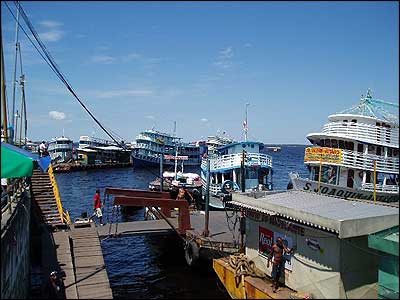
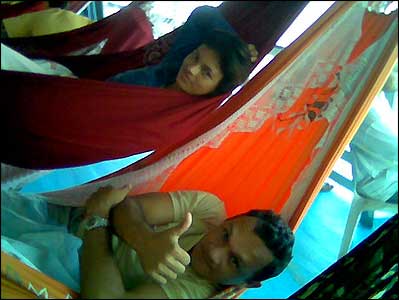
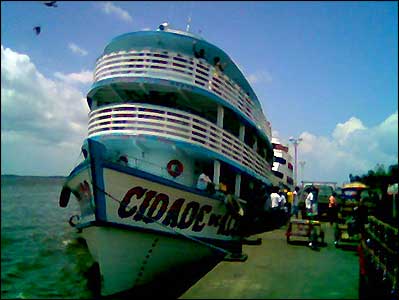
 Cidade de Alenquer – Riverboat.
Cidade de Alenquer – Riverboat.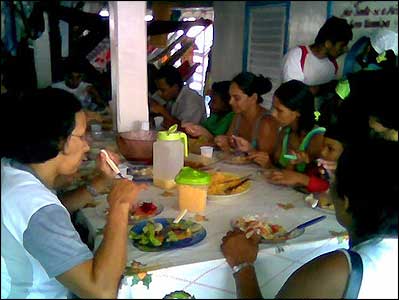
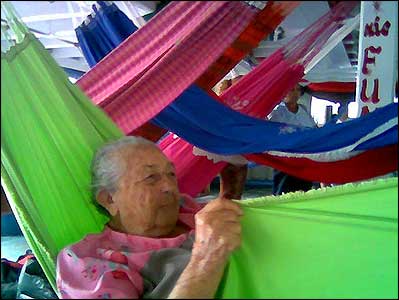

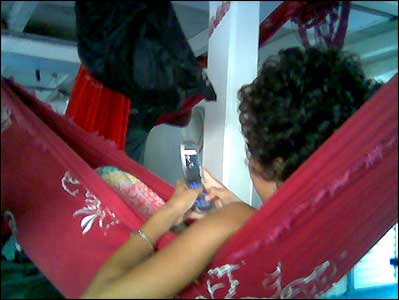

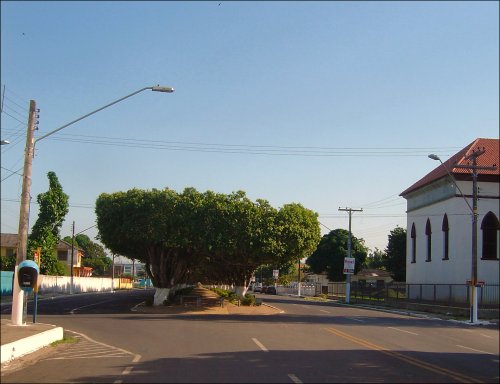
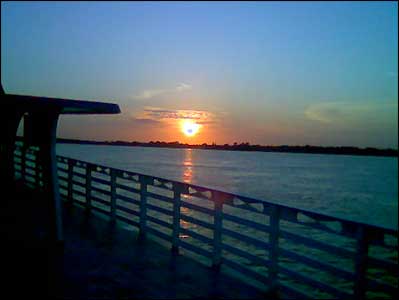
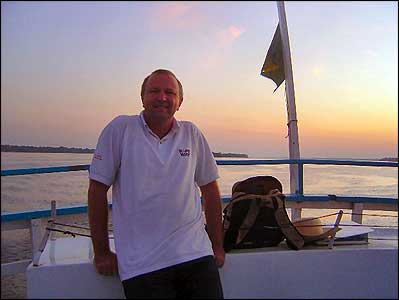







 Facebook
Facebook Youtube
Youtube